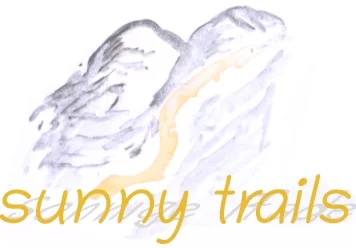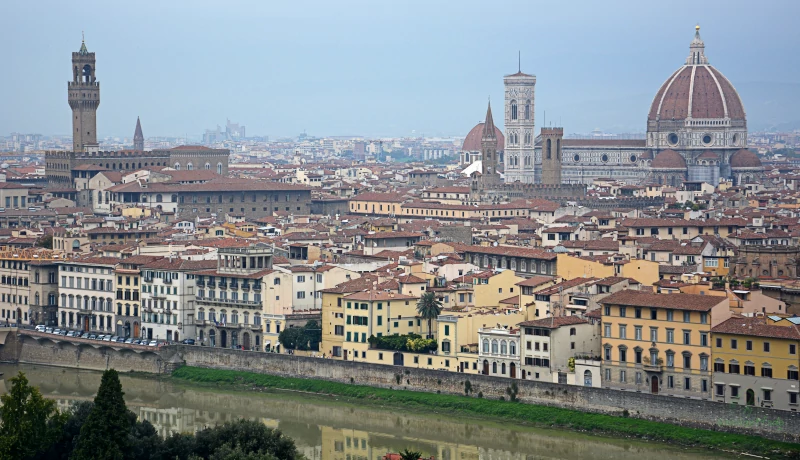
For culture lovers, one city in Tuscany is an absolute „must“ – Florence. For this former Roman army camp experienced a heyday in the Renaissance like no other European city. With the rise of the Florentine merchants, above all the Medici family, works of art in painting, sculpture and architecture were created here, which still contribute to the fame and attractiveness of Florence today.
Art, culture and sights abound – where to even begin in Florence?
[Contains *advertising!]
Where is Florence located?
The city of Florence is located in Italy in a central Italian region widely known for its landscape – Tuscany. This borders the Appenine mountain range to the north and extends in a hilly basin to the Mediterranean Sea. The most important and famous river in Tuscany is the Arno, which also crosses Florence. The Tuscan hills and mountains are famous for their wineries, origin of Chianti wines, sunny hillsides with typical row plantings of columnar cypresses, small churches and secluded villages. Florence, with nearly 400,000 inhabitants, is the capital of the Tuscany region.
It all began with a Roman camp – the history of Florence
Even if the view of Florence today is mostly the Renaissance, I would like to briefly span the entire arc. The history of Florence goes back to the year 59 B.C., when the Romans, under Emperor Julius Caesar, established a military camp in the middle of the Etruscan settlement area. With the name „Florentia“, a flowery development was probably preordained.
The basic structure of the camp is even recognizable today – in a strict north-south orientation, the streets run in a square, which has approximately the Piazza della Repubblica as its center. The Piazza della Signora is located at the southern, the Cathedral at the northern edge of this area. As was customary with the Romans, the army camp also included entertainment facilities such as amphitheaters and thermal baths for relaxing spa and wellness treatments. Even then Florentia was situated at the crossroads of two important roads, the Etruscan road Volterana and the connection to the sea via Pisa, therefore called Pisana.
However, during the Byzantine wars, Florence was quite „under the wheels“ and was largely destroyed. Only after the time of the migration of the peoples a new upswing began. Around 1000, the Carolingian Margrave Hugo moved his seat to Florence. This gave a new impetus to the development. Under the influence of succession – disputes between the Pope and local princes, the citizenry of Florence strengthened, which led to the formation of a city republic in the 12th century.
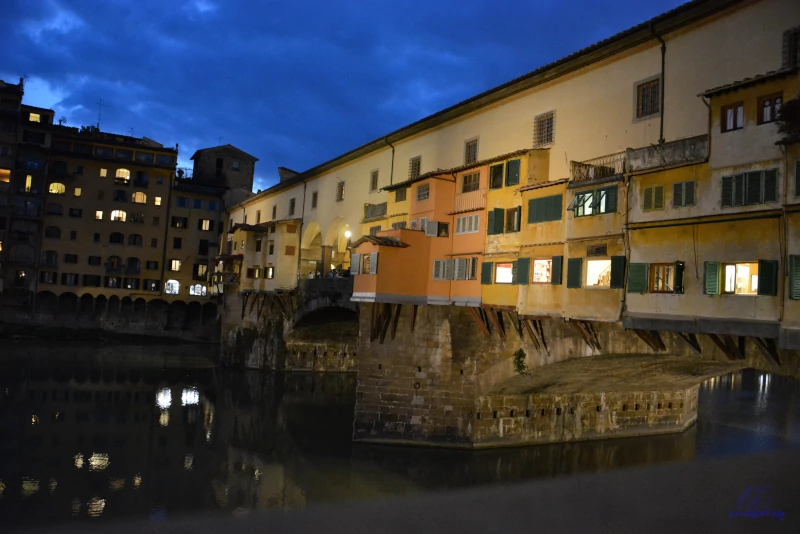
Florence – city-state of rich merchant families – trade across Europe
Florence experienced a bitter five years between 1347 and 1352, when the plague killed about 40% of the population. But after that, an upswing gained momentum that lasted until the 16th century. The Medici Bank, which strengthened the crafts and trade of Florence, made the Medici family dynasty one of the richest families in Europe of the time. Especially under Cosimo de Medici (1389 – 1464), who played a leading role in the republican city and skilfully developed a political network, the importance of Florence in the European trade world grew enormously.
The Medici bank financed merchants, politicians and the clergy; they were the private bank that even the Pope resorted to. Money also ensured the Medici influence in the city and in southern European relations. Formally, Cosimo de Medici accepted the republican constitution of the city-state of Florence, but he certainly used his power for change and further development. The relationship with other influential families in the city was therefore quite ambivalent. In part, they themselves used the Medici bank to finance their business and also supported development, but on the other hand there were always tensions. Thus, in Florence, with the Vasari Corridor, even secret passages were laid out, along which the Medici could visit the houses of the city’s power safely and unnoticed from their palace, without having to move along the normal streets.
Rich merchants promote art and science
On the other hand, the city’s prosperity also meant that artists and scientists could settle and develop relatively freely, which in turn contributed to Florence’s wealth and development. This is how the Renaissance became possible in the first place. Famous names to mention are: Galileo Galilei, Leonardo da Vinci, Michelangelo, Boticelli, Macchiavelli… Most of these outstanding Renaissance figures were universalists, i.e. geniuses not only in one field. Galileo, for example, was a mathematician, physicist, astronomer and engineer, Michelangelo a poet, painter, sculptor and architect. Leonardo da Vinci trades as a painter, sculptor, architect, anatomist and natural philosopher. It is therefore anything but surprising that the entire city community of Florence benefited from the discussion with these celebrities, from the reception of their works and the far-reaching influence.
The rich merchant families were always the patrons of science and culture. They commissioned artists, they took mathematicians, architects and astronomers into their service. Therefore, numerous works of art remained in the city – at first often in private galleries, but later they were transformed into public exhibitions open to the public. Today, Florence has galleries, collections, sculptures and monuments in a density rarely found anywhere else in the world.
A dome without equal of this time – the Duomo Santa Maria del Fiore
Florence can also boast an entire urban structure from this period in terms of architecture. Numerous palazzi, the merchant houses of the rich families in the city form the backdrop to a history that still seems tangible in Florence today. Famous far and wide is the bridge Ponte Vecchio over the Arno river. Most striking, however, is the Cathedral of Santa Maria del Fiore with its huge dome by Filippo Brunelleschi. This cathedral was begun in the 12th century and built until the 14th century, combining Romanesque and Gothic elements.
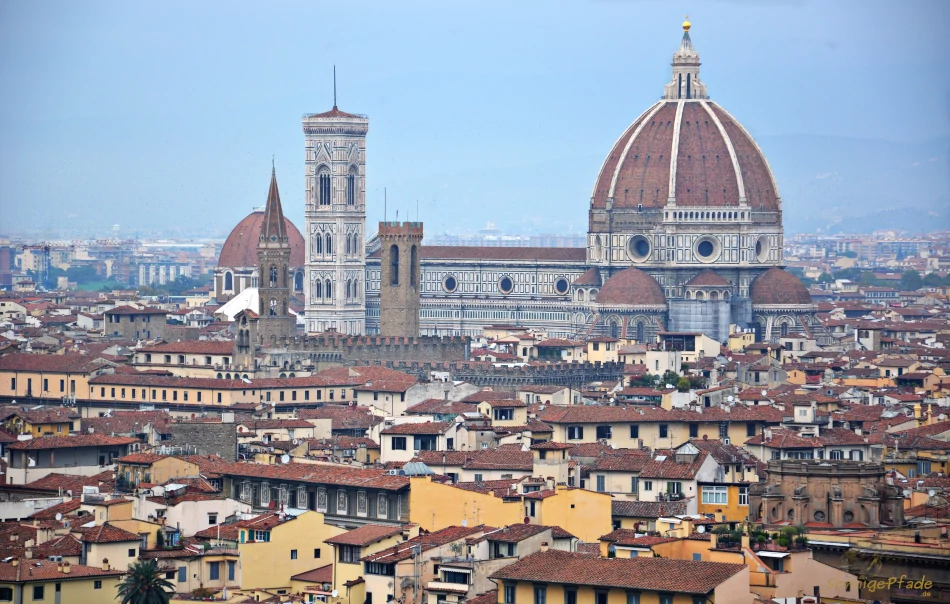
A small but interesting fact for me is that already in 1786 in Florence torture and capital punishment were abolished.
In the 18th century Florence came under the rule of the Habsburgs and was caught up in the turmoil of war between them and French troops.
The 19th century also brought a new economic upswing with the beginning of tourism. The focus was already on educational trips. For a few years Florence even became the capital of United Italy, until this role fell to Rome in 1871. However, industrialization and long-distance trade allowed Florence to strengthen again into the 20th century, along with tourism, which continued to grow. The population also grew. An important industry became the fashion industry with the Gucci brand, and other Italian brands set up branches in Florence.
As early as 1982, Florence’s city center became a UNESCO World Heritage Site, which further boosted tourism.
Discover Florence sights individually
Such a vast number of cultural assets, art and urban ensembles as in Florence makes it quite difficult to give a balanced overview. Where to start and where to stop on a nevertheless limited blog – page? I will try to give a first overview here, point out some special places and possibly treat individual destinations separately in later posts. If you are not mobile enough for an extended tour through the many alleys and streets of Florence, there is the alternative of a ride with an eMobile*.
The tour starts at the train station
You will probably reach Florence by train or by long-distance bus (the city center is largely off-limits to foreign drivers). Then the first place you will most likely set foot is at the Santa Maria Novella train station in the Piazza della Stazione. This square has an almost triangular shape. Opposite the station, on the left, you can see the Basilica of Santa Maria Novella (the back), next to which there is a good access to the old town. Exactly there is also a tourist information, where you can get one of the free city maps, very helpful for an individual sightseeing tour.
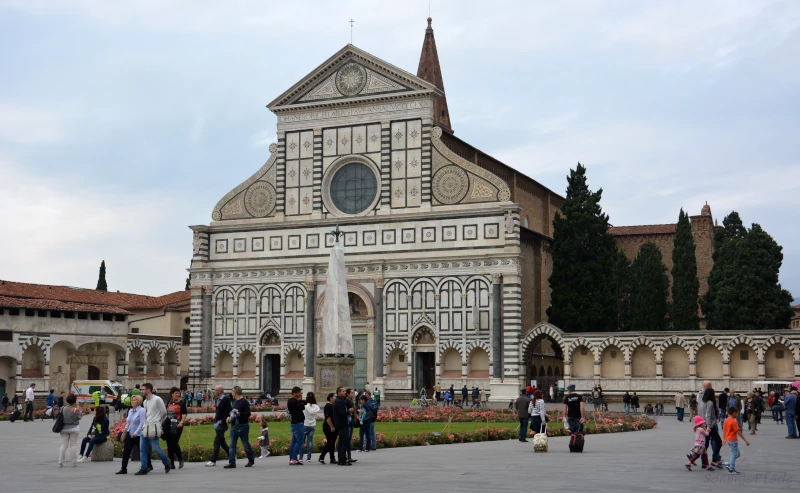
Passing the Basilica, you already come to Piazza Santa Maria Novella. The spacious square with a green area in the middle forms the generous forecourt to the Basilica. This is a popular meeting place for locals, but also many tourists are on the way. At the wall to the church area as well as on the first meters on the square there are various souvenir stands and some odds and ends such as sunglasses, bags, etc.. Fortunately, this is not the case everywhere in the city.
From the Piazza Santa Maria Novella some streets branch off, through which you can reach other destinations. Approximately in the middle of the square, you will come in an easterly direction directly to the Cathedral of Santa Maria del Fiore (approx. 450m).
If you continue along the diagonally branching street, you will reach Palazzo Strozzi after 300m. This is also often the venue for exhibitions. A look into the inner courtyard surrounded by columns is worthwhile.
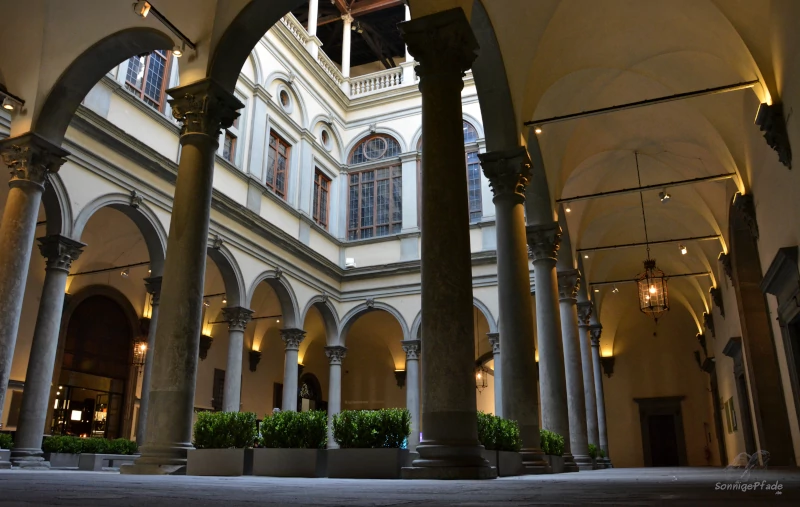
The Arno flows through the city and allows insights
All roads to the south ultimately lead to the banks of the Arno river. This flows roughly from east to west with a slight „dip“ to the northwest through the center of Florence. Or basically passing south of the core, that is, the old Roman camp. For me, such a river in a foreign city is always helpful for orientation. That’s why I recommend walking there right away. At the river, the view opens up, you can see quite far through the city and assign various prominent buildings and towers with the help of the city map. Opposite on the south bank, for example, the Renaissance church Santo Spirito is easy to recognize. From there you can later easily find the Palazzo Pitti.
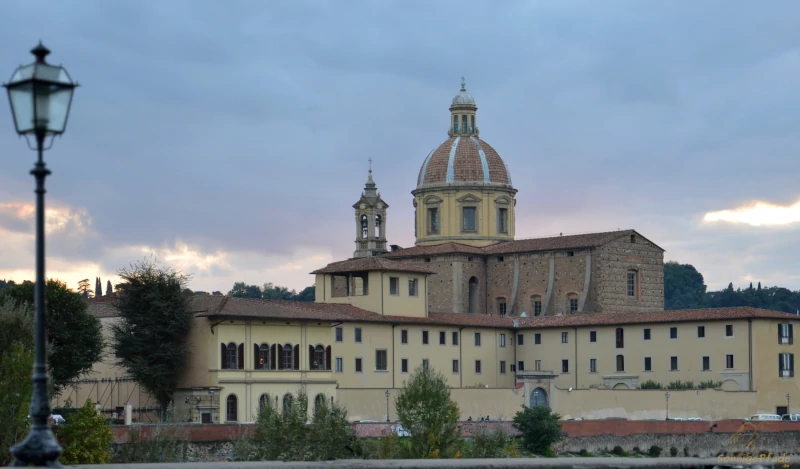
World famous Ponte Vecchio – Bridge with a secret passageway
Upstream, one of the nearest bridges over the Arno is the Ponte Vecchio, easily recognizable by the colorful little houses that practically seem to hang from the bridge’s balustrades.
The Ponte Vecchio is probably the most famous structure in Florence. Of course, there is quite a bit of crowding on and off the bridge at almost all times of the day and night. The late Medici had it easier, because in the „upper floor“ of the bridge superstructure runs the Vasari corridor of 1565, through which the powerful of Florence could pass unobserved from Palazzo Vecchio and the Uffizi Buildings to Palazzo Pitti. The houses on the Ponte Vecchio are mainly jewelry and watch stores for expensive branded goods. You can discover the Vasari Corridor for example on a “Secret Passages Tour” (incl. lunch)*.
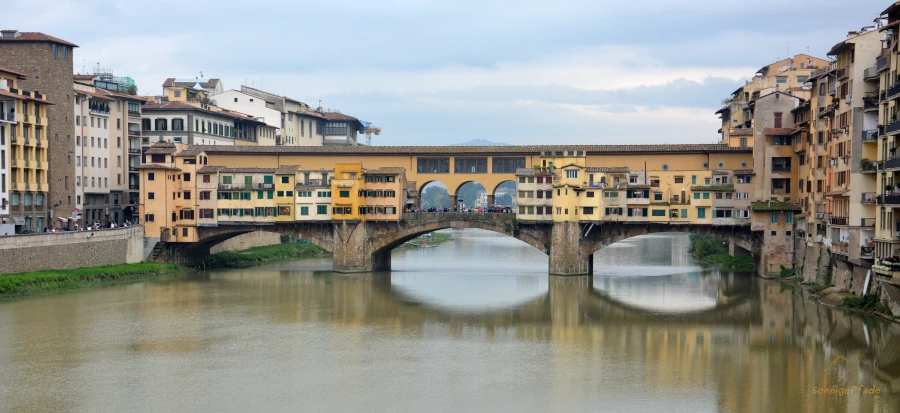
If you don’t cross the bridge for the time being, but walk in the opposite direction down the street and then turn right, you will reach Piazza della Signoria. This is, so to speak, the marketplace of Florence. The Signoria was one of the most important decision-making bodies in the city republic (comparable to a city council). Today, in and around Piazza della Signoria you will find many of Florence’s most famous sights.
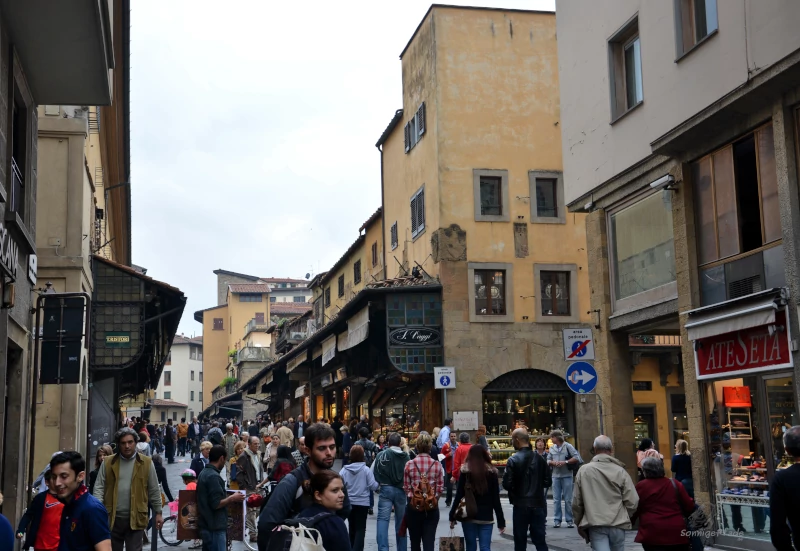
Palazzo Vecchio – center of power of the city republic of Florence
Here stands the Palazzo Vecchio. It has always been a kind of city hall of Florence and was originally called Palazzo della Signoria. Construction began as early as 1299, and the Palazzo Vecchio was completed in 1314. That’s over 700 years to this day! The Palazzo Vecchio was the seat of the guild masters and the various organs of the city republic’s elaborate power system. It was also the residence of the Grand Duke of Tuscany. In front of Palazzo Vecchio there are two marble sculptures – Michelangelo’s David (a copy). The original is now in the Academia di Belle Arti. Opposite the David at Palazzo Vecchio are Hercules and Cacus by Baccio Bandinelli. The main portal of the Palazzo behind the sculptures is called the „Lion’s Gate.“ Why? Well, look more closely at the picture 😉
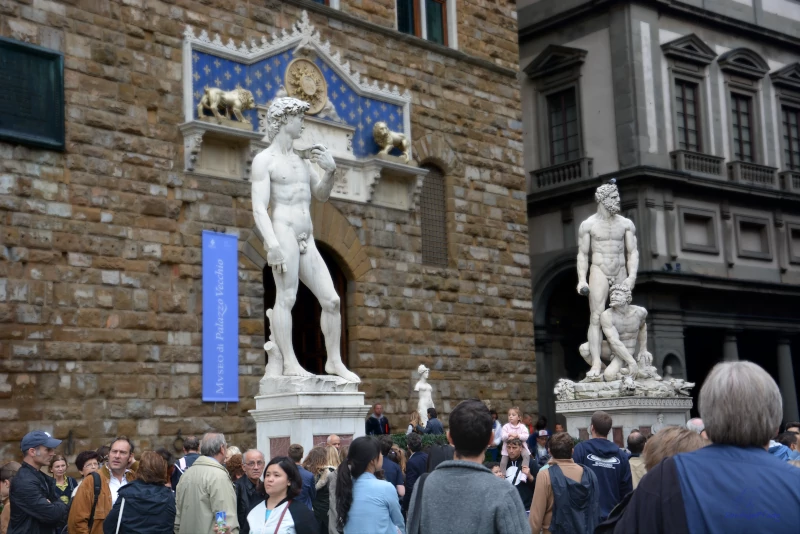
In Piazza della Signoria you will also find the famous Fountain of Neptune by Bartolomeo Ammanati. One of the buildings behind the Neptune Fountain houses a museum of the haute couture label Gucci, which has its home in Florence.
The Uffizi Gallery is accessible from the square. This gallery, founded as early as 1581 by Francesco I de Medici, houses numerous masterpieces from the 13th to 18th centuries by Italian and European painters.

Crowds at the Cathedral of Santa Maria del Fiore
The three streets leading north from Piazza della Signoria always lead you to the Cathedral of Santa Maria del Fiore, one of the main sights of Florence. Next to the cathedral, vaulted at the east end by the huge dome, is a campanile – the largely free-standing tower to the cathedral. East of the cathedral dome in the small square you will find the Museo dell’Opera di Duomo (Cathedral Museum). The building is the former cathedral building lodge. Today it contains an extensive sculpture collection with works by Michelangelo, Donatello, etc.

That was in fast forward the inner core of the old town – center of Florence with some of the most important sights of this Renaissance – city. Of course, there is much more to discover everywhere, including other palazzi and small stations. For example, in one of the alleys there is an old olive tree (now largely „enclosed“). This rather plucked-looking, clinging to life tree reminds of a bomb attack of May 27, 1993, which the olive could survive with its strong driving force.
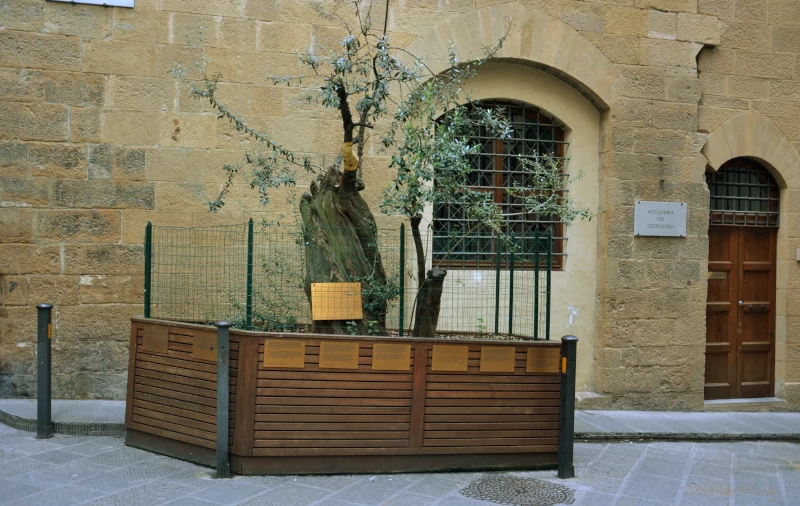
Florence worth seeing south of the Arno
If you cross the Arno on the Ponte Vecchio or one of the other bridges, you’ll come to the Santo Spirito district. In the square of the same name in front of the church, there are occasional (Sundays?) regional markets where small producers offer everything from vegetables, cheese, herbs and creams to bread and rolls, baskets, hats and headdresses. The market is also interesting for „non-consumers“ as it reflects a piece of the lively city and local culture that is still well rooted in Tuscany. In Piazza Santo Spirito you will also find my „favorite Osteria“ of the same name.

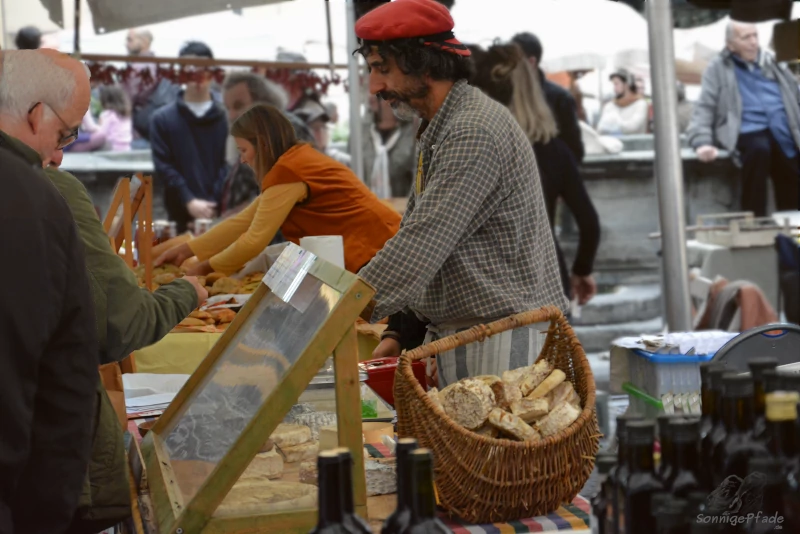
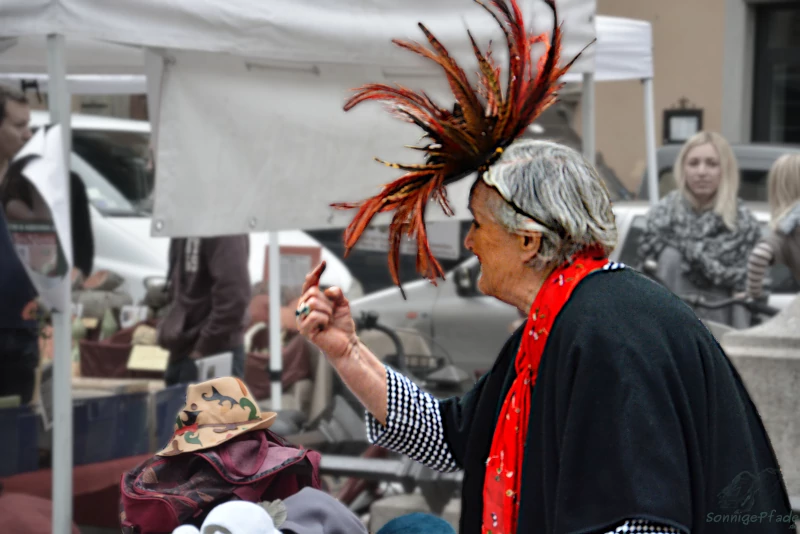
The Palazzo Pitti – a palace of art
Not far from Santo Spirito stands the Palazzo Pitti. This one is not exactly a beauty on the outside, like many of the palazzi in Florence, by the way. The merchants of the Renaissance preferred to build fortress-like ground floors with a few high narrow windows, behind which their warehouses were located. This was to keep out thieves and protect the large stocks of goods from fires. Unfortunately, this can sometimes be a bit of a deterrent to visitors. If you can catch a glimpse of the inner courtyards, it is all the more pleasant. These are often atriums with columns and arches, playful courtyards, sometimes fountains or sculptures.
Palazzo Pitti houses several galleries. These are the private collections of the Medici with Renaissance art, e.g. d’Arte Moderna, del Cstume, Palatina, Museo degli Argenti. Behind Palazzo Pitti is the Giardino di Boboli (Boboli Garden), an extensive landscape garden with many sculptures.
Good views from Piazzale Michelangelo
If you walk back along the Arno River in an easterly direction, you will also find a stairway to Piazzale Michelangelo. From up there you have an excellent view of the northern part of Florence. This is especially the „viewpoint“ for the famous view with the Cathedral of Santa Maria del Fiore, in which the incredible proportions between „simple“ town houses and the huge dome of the cathedral become visible.
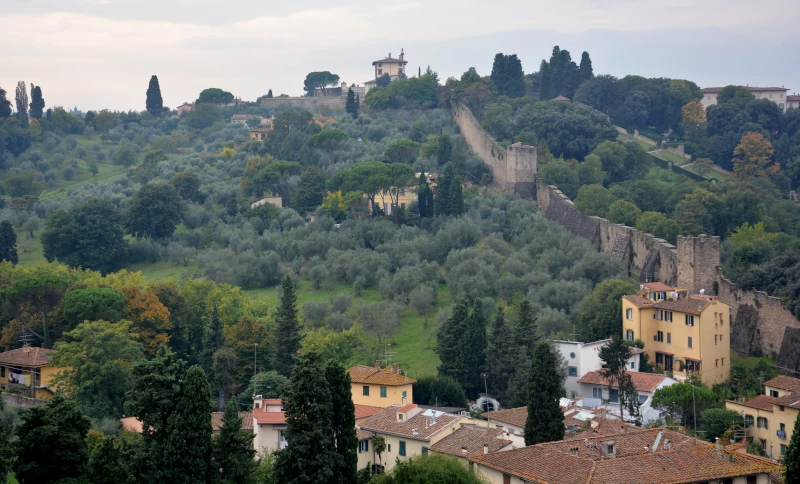
From this vantage point you can also see the Gothic Basilica of Santa Croce on the opposite bank of the Arno River. A visit to this church is especially interesting because you will find the tombs of Florentine celebrities like Michelangelo, Galileo Galilei, Gioachino Rossini and others. Even these tombs are works of art in their own right!
If you see a large nave, side aisles and tower in gray-brown natural stone from the vantage point at Piazzale Michelangelo, the character changes completely when you walk from the city center toward the west portal of Santa Croce. This is in light gray Renaissance style. Once around the corner, you jump back two hundred years in history. This can be seen in Florence at several churches, e.g. also at the Santa Maria Novella opposite the train station. Sometimes it’s really hard to believe that you’re standing in front of the same building.
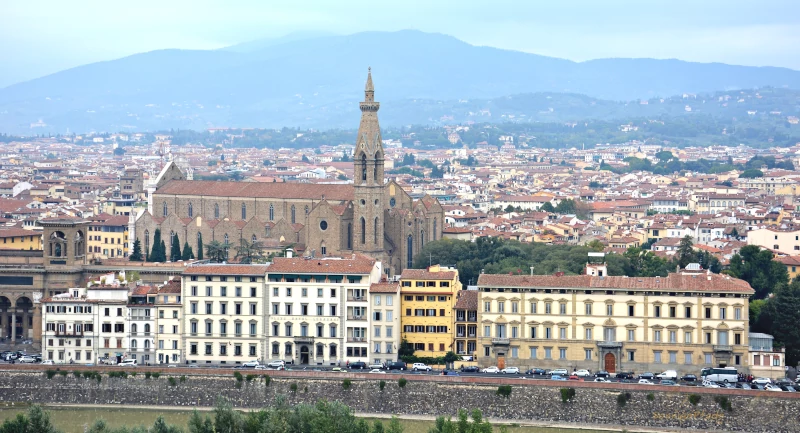
Overall, there is much more green in the Santo Spirito district south of the Arno. Gardens and parks have been laid out on the slopes and various paths make a walk a pleasant enjoyment. Surely you will find one or the other photo spot for an individual picture of Florence.
Museums in Florence
There are a lot of museums and galleries in Florence. I will probably not be able to give you a complete overview here, although I will add to it from time to time.
- Already mentioned was the Palazzo Pitti with the private collections of the Medici: d’Arte Moderna, del Cstume, Palatina, Museo degli Argenti. The regular entrance costs 12€, 3€ more allow an “entrance reservation”. Here you can book online your ticket for the Palazzo Pitti* at a fixed visiting time.
- Also already mentioned the Uffizi with the Museum of Classical Art and Italian Painting. You can buy a time-limited ticket to the Uffizi online here*.
- The Accademia di Belle Arti houses the art museum Galleria dell‘ Accademia, where among other things the original statue of David by Michelangelo can be seen. You can reserve a timed ticket to the Galleria dell’ Accademia online* in advance here*. Note the exchange of the voucher in the building opposite. You can book a guided tour optionally here*.
- The Accademia also includes the Opificio delle Pietre Dure. This is a museum of Florentine restoration workshops – interesting that with so many art treasures even their preservation and restoration becomes the subject of an extra museum.
- The scientist and artist Galileo Galilei is dedicated to an extra museum on the banks of the Arno.
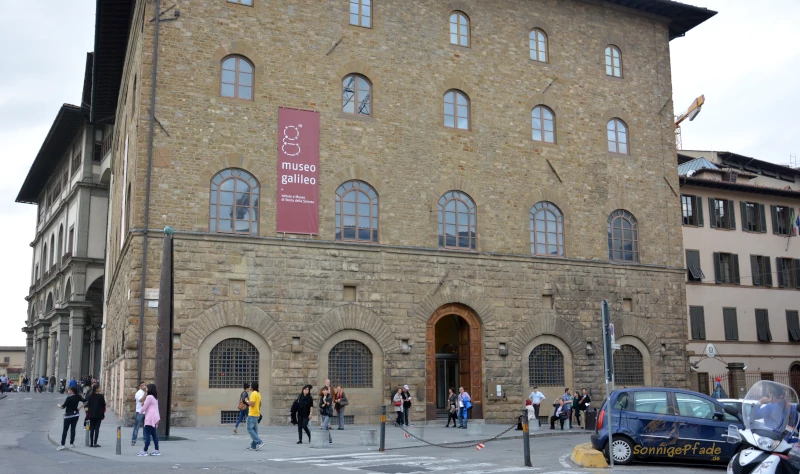
- The Palazzo del Bargello (also Palazzo del Podestà) houses a museum with works of sculpture. There, in addition to Donatella, Giambologna and Michelangelo, are sculptures and paintings by masters not known by name. Reserved Ticket to Palazzo del Bargello*.
- Already mentioned above, the Museo dell’Opera di Duomo (Cathedral Museum) to the east of the dome.
- There is also an archaeological museum in Florence, the Museo Archeologico Nazionale.
- In the Palazzo Strozzi the exhibition contents change – there are also modern topics with present – artists

Culture in the evening – opera in Florence
If your legs ache in the evening, you can continue to enjoy the opera sitting comfortably: The Opera di Firenze invites in the new modern opera house „Nuovo Teatro dell‘ Opera„ next to the Stazione Leopoldia – Porta al Prato to enjoy Italian operas in original language and current production. Those who don’t speak Italian and don’t know the libretto anyway, can follow the content via superimposed English subtitles. Tickets are also available at the ticket machine in front of the opera house (payment by credit card). The visit is worthwhile, but not on the cheapest seats, which are offered for only 5 euros. My mistake at the first attempt: These seats are on side rows and one looks stupidly on a concrete wall, the stage is rather not to be seen. Those who invest more will be rewarded with an opulent production at the Opera di Firenze.
Opera performances including a dinner* in the concert atmosphere of the St. Stefano al Ponte church can be booked online here.
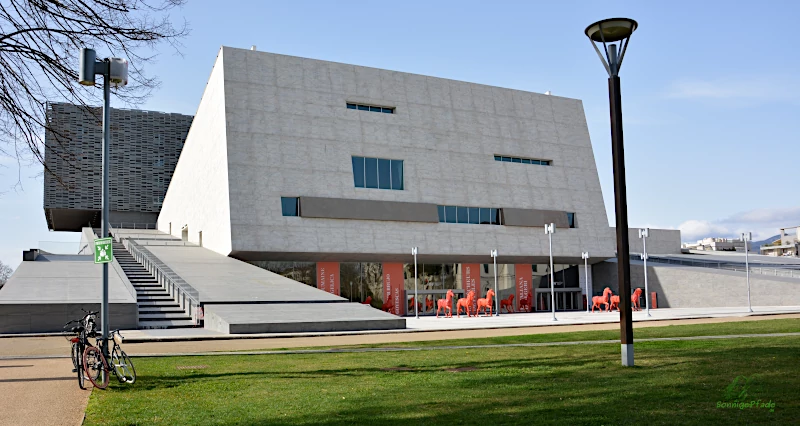
Travel tips for Florence and Tuscany
Getting to Tuscany
Florence is also the best place and starting point for a tour in the Italian region of Tuscany. This is because it is where the various modes of transportation come together and there are good regional and international connections.
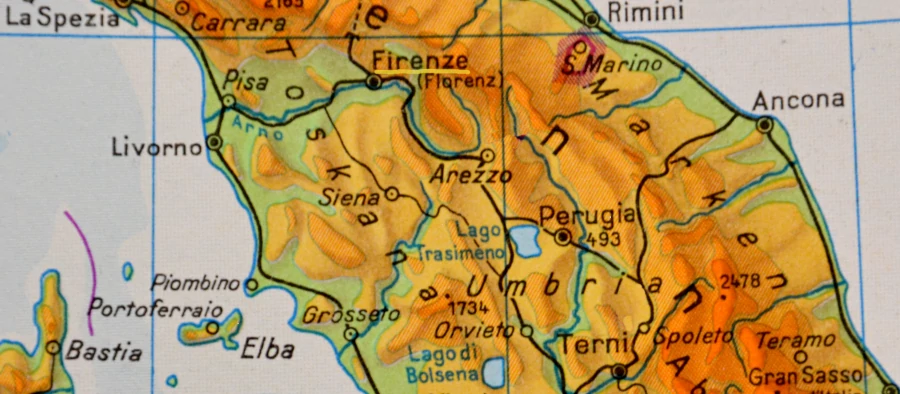
Florence by plane
Florence has a smaller airport (IATA code FLR). This is certainly convenient (if you have the starting airport under your nose), but not exactly climate-friendly. In Florence, a few years ago, the streetcar – line 2 runs from the airport in about 20min directly to the central train station Stazione Santa Maria Novella.
By train to Florence
This is relatively easy, if you are in Middle Europe or already in Italy. Florence is also still one of the European places for which trainline* can issue connections and online tickets. With the relatively short distance and good connections from central Europe, the train is actually a very convenient means of transport for the tour to Florence.
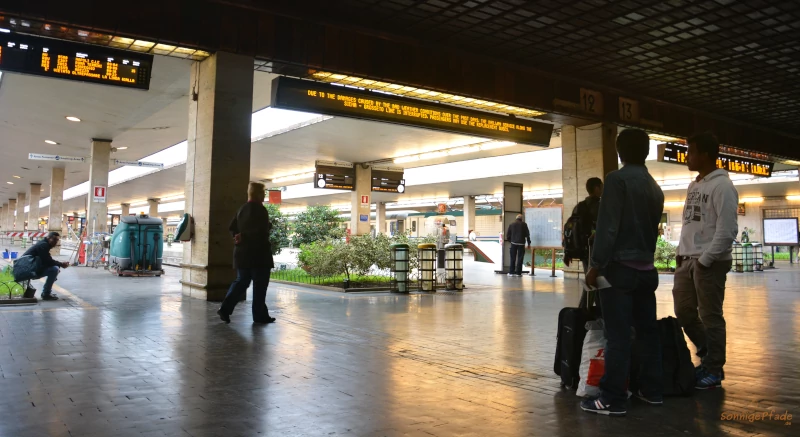
By long distance bus
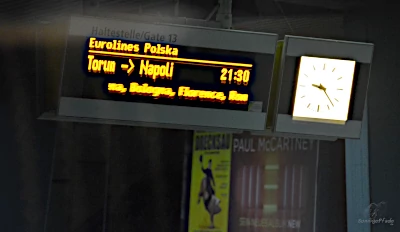
Long-distance bus driving in Europe is popular, especially among budget travelers. Connections from Central Europe are available mainly through the Alps via the Brenner freeway. Even from Central Germany, the journey by long-distance bus overnight is possible and quite pleasant, especially since then the landscape of Italy slowly appears outside the windows. So you can feel like the famous german poet Goethe or the noble Franz von Anhalt-Dessau on a trip to Italy! They even used to travel such distances by stagecoach. One provider of long distance bus connections is Eurolines Polska, which offers a connection from northwestern Poland to Naples every night.
Via the Czech Republic with a change in the czech capital Prague and further via Vienna and Venice, the Czech long-distance bus provider RegioJet* provides comfortable connections and even with some service at the seat, such as hot and cold drinks and small snacks.
In order to search for other long-distance bus connections or train providers, you can use omio as an intermediary and online booking portal*.
The bus terminal of Florence is located west of Santa Maria Novella station in the small street Via Santa Caterina da Siena, practically in a backyard, which is accessed through a gateway.
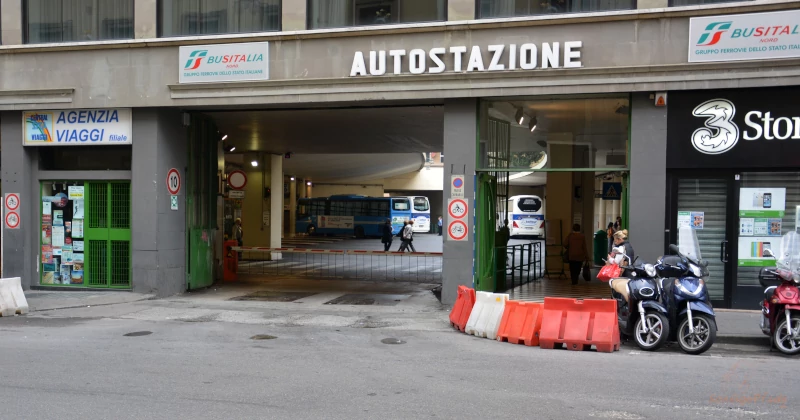
To Florence with your own car or rental car
Of course, this is also possible. Italy has long been a popular destination especially for southern Germans, Austrians and Swiss. Especially by car (or rental car*), because the distance is relatively short. The former will usually arrive via the Brenner Pass and South Tyrol. The connections via highways are well developed, Florence is located on important highways as it was in Roman times: E45 / A1 Milan – Rome and A 11 Pisa – Florence. Many caravan sites near places worth seeing also make the trip with your own or a rented camper van* to Tuscany an individual adventure.
However, you have to keep in mind – Florence has a strict city toll system and the city center is only open to residents at most times (zona a traffico limitato). If you enter the restricted areas without authorization, you will be automatically recorded and get a hefty fine. Therefore, it is better to book an accommodation with parking outside and use the city buses or the streetcar.

Weather in Florence and best travel times
A visit to Florence is, of course, the most fun when the sun is shining and the blue sky makes the orange-red roofs glow. Therefore, the trip to Florence is recommended especially in the spring from the end of March and until the fall – possibly October. In winter it can also be cool and especially more often wet there. But you should avoid the summer months of July and August! Because then temperatures can reach over 40°C, which leads to sweltering heat in the city and is no longer a pleasure.
In addition, during this peak season (then already from the end of May), the most important museums are often booked up for days. For relaxed gallery visits, the off-season in spring or fall is preferable. If you want to visit only houses, because you already know the city and the gardens, it is better to use the winter – then the art enjoyment in Florence will be more or less relaxing. There will still be a few hours of sunshine for the „bright spot“ even at this time of year.
Rustic food in Santo Spirito
Of course, there are plenty of osterias and restaurantes in Florence, from very simple to upscale gastronomy. A real treat for me was the cheese gnocchi at Osteria Santo Spirito along with a glass of Chianti – red wine from the Tuscany wine region south between Florence and Siena. Discovered rather by accident on my first visit to Florence in the last two hours, I sought out this simple, rustic osteria with rough stone floors and half-height wood paneling at the next opportunity. The gnocchis freshly prepared, very hot in the first moment and very spicy in taste were the end of all wannabe pasta from Italia street food.

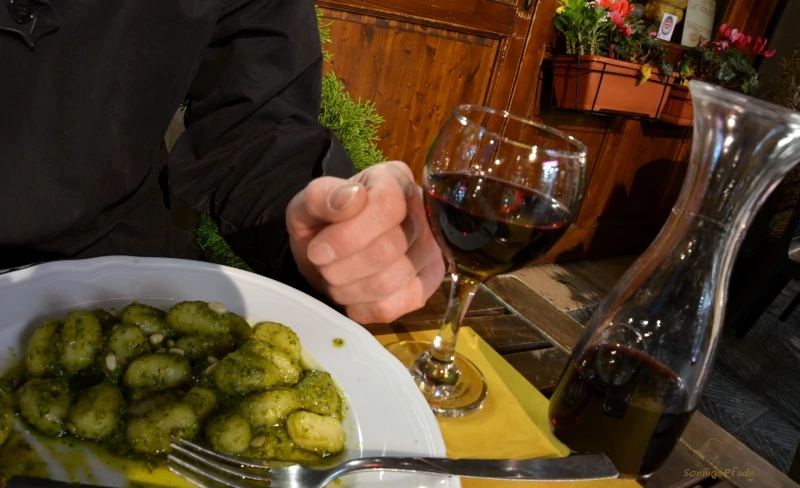
Gelato italiano – ice cream for your tongue
On the same side of the Arno river just past the Santa Trinita bridge, the eye eats at the ice cream stand! This gelateria Santa Trinita melts into your local memory with a gently fruity glacier over your tongue. Delicious mountains of various flavors are popular with locals and tourists alike.
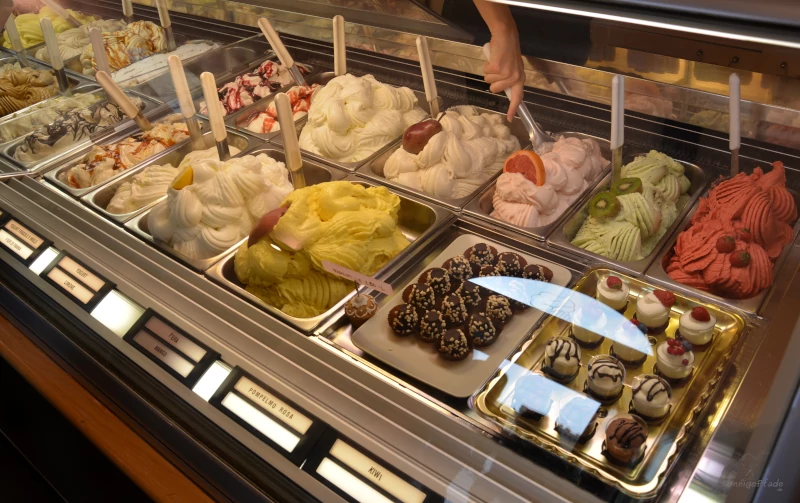
Accommodation in Florence – from hostel to hotel
Although there is a huge number of accommodations on different levels in a cultural and art city like Florence, it can be tight with the hotel – booking in the summer, respectively expensive. As already said under weather and best travel times for Florence, also applies to the hotel – selection: Swimming against the trend is not such a bad idea – why not fall back on the off-season for the visit to the numerous museums and exhibitions of Florence or use the winter right away, if’s anyway mainly ‚indoor‘ – experiences should be. To note: Florence charges a „City-Tax“ per night, which usually has to be paid in addition to the accommodation costs.
From the numerous accommodations in Florence, I have selected a small choice, from budget to upscale and luxury pure, in the hope that for your Florence trip the right accommodation is there:
Florence budget – accommodation in hostels
For absolute budget travelers – the cheapest accommodation is offered by the Florence Dance Hostel* with dorm beds from 9,00€ in an 8 bed mixed dorm. This doesn’t have to be „cheap“ – guests usually rate the Florence Dance Hostel as good and pleasant. It is located on Via Nazionale in a multi-story house on the 3rd floor. For a little more, there are 6 Bed Dorm rooms with 6 guests, optionally as mixed dorm or as women – room. Breakfast is not included.
Only a little more expensive from 12€ is the Dorm – bed in the Annamaria Florence Hostel*. Here there are 6 – and 4 – bed dorms mixed or for women. The beds have curtains for more privacy. With a distance of 1,3km to the city center, everything is still easy to walk. Coffee/tea facilities are available. Emerald Palace Hostel Florence* offers both dorm – beds and private rooms for 2 to 4 guests. Accommodation in dorm – beds starts from 18€. There is an upper age restriction – guests must be under 50.
Middle class accommodation
With only 300 to 500 meters to the main sights such as the Duomo Santa Maria del Fiore or the Uffizi Gallery in the center of Florence, the Boutique Hotel del Corso* is an almost unbeatable address in this price range for your Tuscany trip. And what’s more, as a guest you are accommodated in a 16th century palazzo and have an unbeatable view over the Renaissance city from the hotel’s terrace. A rich choice of rooms of various sizes, including family rooms, offers guests in this hotel good accommodation in all constellations. Parking, however, is available only in public parking lots nearby and is subject to a fee.
Hotel degli orafi* also lets you immerse yourself in historic Florence from the moment you arrive. Located in an old Augustinian monastery, with the remains of a medieval tower in the grounds and the Uffizi Gallery around the corner, you’re practically living in the middle of the Renaissance with its sights, galleries and exhibitions. With a spacious family suite, the hotel is not only open to families, but is also (partially) handicapped accessible with an elevator and specially equipped rooms (on request). Parking is also available here only nearby in a parking garage for a fee (35€/d).
A little further from the center of Florence is the Hotel David* but there is free parking at the house (reservation required) and virtually in front of the door a bus stop, so that you can reach by bus in 5min the historic center of Florence. On foot it is about 1,5 – 1,7 km to Ponte Vecchio and Uffizi Gallery. Hotel David has a rich choice of rooms mainly for couples, but also triple and quadruple rooms. Some of the rooms are especially equipped for disabled people. There is also parking for the disabled. A charging station for e-cars is also available. Pets are allowed in the Hotel David.
Florence Luxury Class Hotels
If you want to immerse yourself in the Renaissance from the moment you arrive, make a note of The *****St. Regis Florence Hotel*. That’s because the building was designed by Filippo Brunelleschi, who created the dome of the Cathedral, in the 15th century, sits right on the Arno River and overlooks the Ponte Vecchio. Rooms are decorated in Florentine style with antique furniture, and bathrooms are lined with marble. In the hotel there is a wellness and fitness area. Pets are allowed by appointment.
The *****Roco Forte Hotel Savoy* is located between the Duomo and the Uffizi Gallery and is thus ideally situated for enjoying Florence’s culture. The contemporary furnishings of the rooms in Florentine design and with works of art from Tuscany make a stay in the art metropolis of Florence authentic. An extensively equipped fitness center offers respite from the mental demands of the art reception. Parking is available by reservation for about 50€/d in a parking garage nearby.
The ****Galery Hotel Art – Lugarno Collection* not only awaits art lovers as guests, it also hosts contemporary art exhibitions itself. And the Ponte Vecchio is practically on the doorstep. Thus, the Gallery Art Hotel Florence is a good place to wake up in the morning with art and in the evening, exhausted, to enjoy the tranquility of the spacious rooms. Guests of Gallery Hotel Art can also relax in a wellness and spa of the partner hotel Continentale. Pets are allowed in the hotel. Parking is available in a nearby parking garage for a fee.
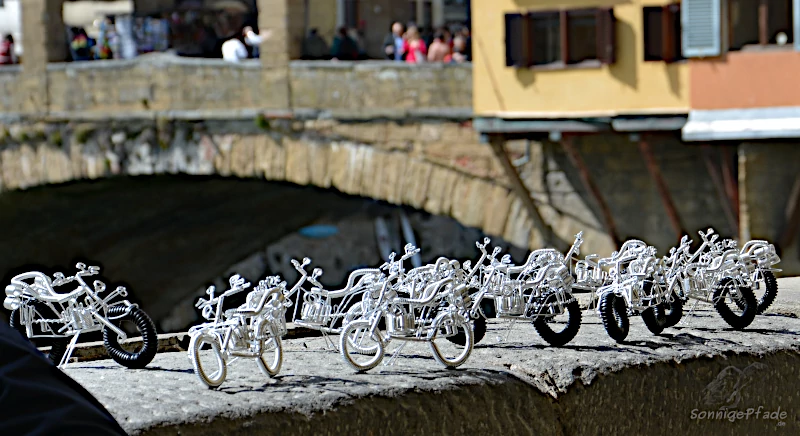
Tuscany from above – with the hot air balloon
If you want to see the rich landscape of Tuscany with castles and vineyards from above, you can start from Florence for a ride in a hot air balloon*. The balloon ride lasts about 1 hour, with arrival and departure and the preparations you have to plan about 3 hours for this pleasure.
Discover the Tuscan countryside and vineyards
Out to the Chianti wine region! From Florence there are various offers to tour the area with wine tasting. In a small group* this is possible from 4-5 hours. The Tuscany tour will be really Italian like with a Vespa* (driving license required) or like the first date with a Fiat 500* for lunch with wine tasting. If you want to spend more time exploring Tuscany and its wine culture, you can take a full-day tour* to get to know the wine-growing and culinary specialties of the Florence area.
Fancy a trip to Florence? Invite your friends!
If you like the post, I’m happy about a comment. And to invite your friends to enjoy art in Florence, share the link to the post in your social media channels!
Note on advertising links
Some of the links in the post are marked with *. These are so-called affiliate links, which connect with an agency or a store. If you click on the link and order something there, „Sunny Paths“ receives a small commission to pay the operating costs for the blog. Nothing will be more expensive for you, because the commission is already included in the price.
Image source product images – manufacturer / dealer
